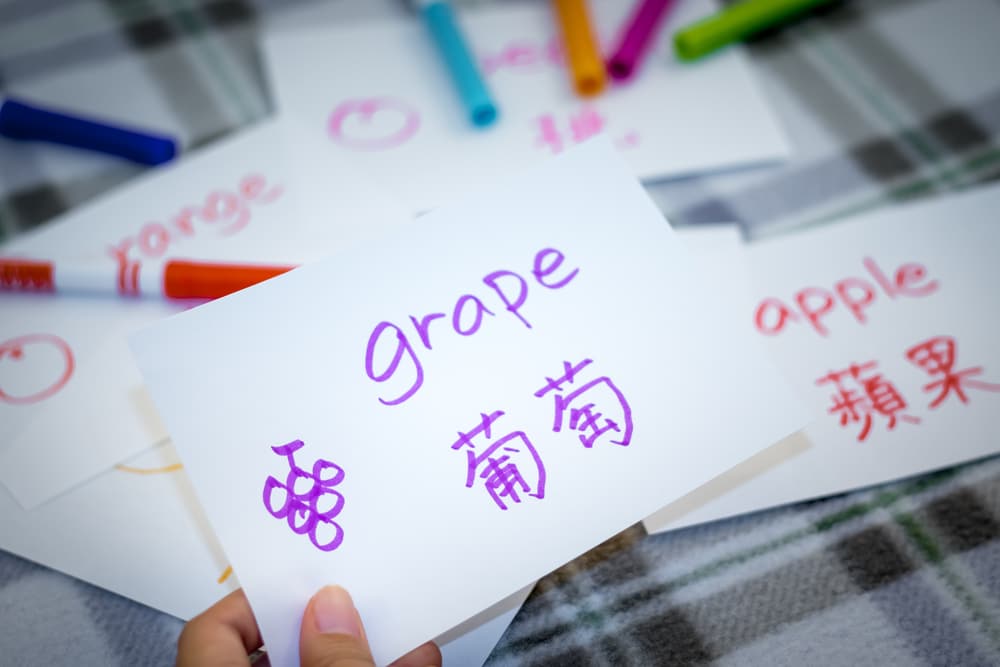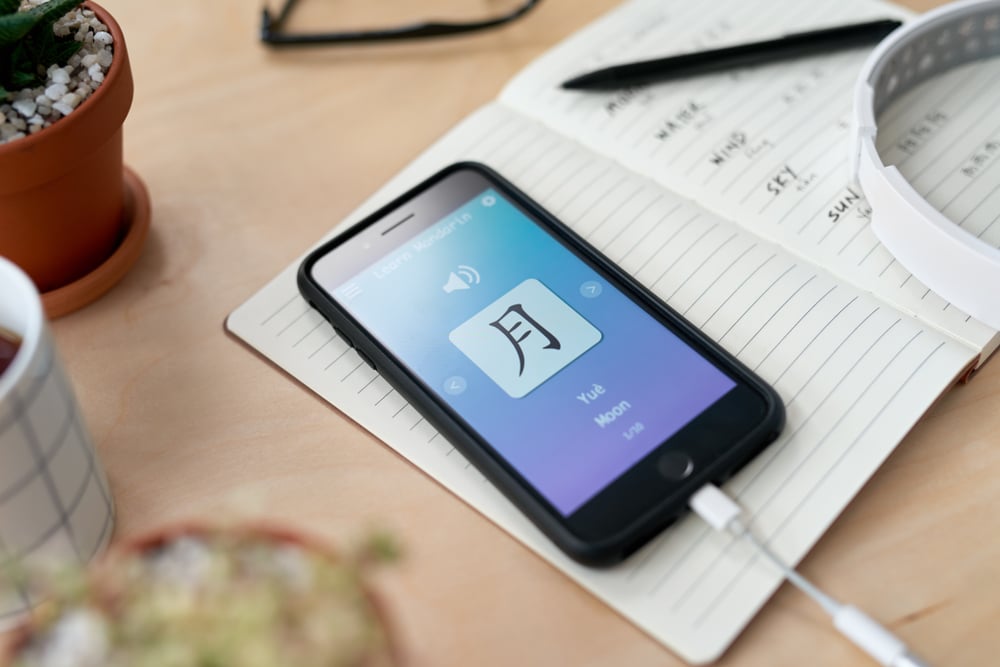
How To Learn Chinese By Yourself: My 15 Best Tricks and Techniques
Wondering how to start learning Chinese?
Doing this on your own can be difficult, but I’m here to tell you the steps that worked for me.
Following a step-by-step approach means you don’t need to pick and choose what to focus on blindly—I’ll walk you through the most important things to know and resources for learning them.
Plus, Chinese can seem especially intimidating for English speakers, but a solid learning plan will banish any fears or hesitations.
So, read on to discover the 15 steps for setting out on your Mandarin learning journey!
Contents
- 1. Learn Pinyin and the Chinese Tones
- 2. Set Goals and a Study Plan
- 3. Start with Chinese Greetings
- 4. Learn Basic Sentence Structure
- 5. Group New Words by Theme
- 6. Tackle Chinese Characters
- 7. Try Mandarin Courses on Coursera
- 8. Use Language Apps
- 9. Combine Your Interests in Learning
- 10. Practice with Native Speakers
- 11. Use the Internet in Chinese
- 12. Watch Chinese Videos, Shows and Movies
- 13. Study with Music, Audiobooks and Podcasts
- 14. Record Your Own Study Material
- 15. Practice Every Day
- Where to Learn Mandarin Chinese
- Is It Easy to Learn Chinese?
- How Long Does it Take to Learn Chinese?
Download: This blog post is available as a convenient and portable PDF that you can take anywhere. Click here to get a copy. (Download)
1. Learn Pinyin and the Chinese Tones
Pinyin is Chinese written phonetically in the Latin alphabet. It’s a fantastic invention that helps connect English speakers to the world of Chinese.
You can learn how to pronounce Chinese words by learning pinyin here. I recommend memorizing the sound of each letter in the alphabet before moving on to full words. You can also use this pinyin guide from BBC to make sure you get it.
Additionally, I recommend printing out a pinyin chart and taping it to the front of your notebook. Here’s one from Purple Culture and one from CLI. Don’t be afraid to refer to the chart(s) for help as you continue learning!
But pinyin doesn’t only tell you the phonetic pronunciation of Chinese words—pinyin also tells you the tone of each syllable.
As you probably already know, Chinese is a tonal language. There are four tones and one neutral tone (which could arguably mean there are five tones). Here are the four tone markings:
- First tone: lē
- Second tone: lé
- Third tone: lě
- Fourth tone: lè
Here are the four tones in context:
| Pinyin | Chinese character | Meaning |
|---|---|---|
| mā | 妈 | mother |
| má | 麻 | hemp |
| mǎ | 马 | horse |
| mà | 骂 | scold |
You can learn more about Chinese tones here. You can and should also reference videos and audio pronunciation guides, such as this video from ChineseFor.Us.
Since the way you say a word changes its meaning, pronunciation carries a much heavier weight in Chinese than in many other languages. You don’t want to be talking about a horse (mǎ with the third tone) when you’re really referring to your mother (mā with the first tone)—I would know because I did this!
So spend a good amount of time listening to and identifying the tones, and practice them out loud.
Don’t move on until you have a good grasp of pinyin and tones. If you’re not a pro at using tones yet, that’s fine and totally normal. But learning pinyin and tones first will give you a solid foundation for expanding your Chinese knowledge.
2. Set Goals and a Study Plan

Now, before you dive into vocabulary and grammar, set some Chinese learning goals and write up a study plan.
Having a solid routine that works toward realistic goals is just as important as learning vocabulary.
So, why are you studying Chinese? What is your long-term goal? Maybe you want to…
- …talk with distant family members.
- …live in China for a year or more.
- …watch Chinese dramas without subtitles.
If you need a specific goal to aim for, use HSK character/word lists to give your learning a clear direction. Each of the exam’s levels has an associated vocab list comprised of hundreds of characters and words.
After you’ve determined your long-term goal, create a study plan with clearly defined short-term goals.
First, ask yourself:
- How much time do I actually have?
- How much time am I able and willing to devote to learning Chinese?
It’s good to start small, especially with a language you’ve never studied before. Consider aiming for just 15 to 30 minutes a day at first, rather than starting with a few hours.
Regardless of how busy a life you live, be realistic about how much time you can devote to Chinese. Write it down. Make that your goal each day. You can always tweak your schedule as you find out more about what works for you and what doesn’t.
Here’s a learning plan I made early on in my Chinese journey (transcribed from a stained napkin!):
Weekly Goals:
- Learn 70 new characters.
- Spend two hours listening to Chinese radio.
- Watch one episode of a Chinese TV show.
- Write one 300-character essay.
- Learn three new grammar rules.
Daily Plan:
- Monday: Write out each new character twice, and then add them to flashcard software. Finish the study with one hour of Chinese radio.
- Tuesday: Spend 30 minutes reviewing new character flashcards, then watch a Chinese TV show episode.
- Wednesday: Focus on grammar. Learn some new grammar rules as outlined in the goals.
- Thursday: Write a Chinese essay, then practice writing any new characters.
- Friday: Listen to another hour of Chinese radio.
- Saturday: Test recall of new characters and grammar rules.
- Sunday: Rest day.
It’s important to plan out exactly how much time you’ll spend doing which activities. That means you won’t get sidetracked or bored, and you’ll be on the way to completing your goals.
And keep in mind that a bad routine will stress you out, but a good routine will excite you.
3. Start with Chinese Greetings

Now you’re ready to learn the basics. As with any other language, being able to greet others and introduce yourself is your first priority.
Below are some of the most common words and phrases you may hear in Chinese. You don’t need to worry about the characters yet—they’re mostly here for reference.
Try reading the pinyin and pronouncing them on your own first, and then listen to the audio and see if you got it right.
- 你好 (nǐ hǎo) — Hi/Hello
- 你好吗? (nǐ hǎo ma?) — How are you?
- 早安 (zǎo ān) — Good morning
- 回头见 (húi tóu jiàn) — Goodbye/See you later
- 你叫什么名字? (nǐ jiào shén me míng zì?) — What is your name?
- 我叫… (wǒ jiào…) — My name is…
- 我听不懂 (wǒ tīng bù dǒng) — I don’t understand
- 我不知道 (wǒ bù zhī dào) — I don’t know
- 对不起 (duì bù qǐ) — I’m sorry
- 谢谢 (xiè xie) — Thank you
- 不客气 (bú kè qi) — No problem (used as a response to an apology or a “thank you”)
- 厕所在哪里? (cè suǒ zài nǎ li?) — Where is the bathroom?
- 生日快樂! (shēng rì kuài lè!) — Happy birthday!
One helpful tip is to learn the meanings of individual words as you go along. For example, the first word, 你好, can be broken down to 你 (nǐ) — “you” and 好 (hǎo) — “good.”
Learning individual words in phrases will make things easier since you’ll be able to see the logic and, of course, expand your vocabulary.
You can continue learning greetings and basic phrases with resources on the Chinese-Tools website or via Mandarin phrasebooks, such as those from Lonely Planet. Make sure to listen to audio examples and practice speaking with the correct tones!
4. Learn Basic Sentence Structure
By now you’ve got a good grasp on Chinese pronunciation and you’ve learned some basic vocabulary.
That means it’s time to start learning how to form sentences!
In general, simple Chinese sentence structure is very similar to English. In fact, the most basic sentence structure is the same in both languages:
Subject + Verb + Object
Let’s take a look at some examples:
我爱你。 (wǒ ài nǐ.) — I love you.
我会说英文。 (wǒ huì shuō yīng wén.) — I can speak English.
我吃早饭。 (wǒ chī zǎo fàn.) — I eat breakfast.
You can learn more about basic Chinese sentence structures here. You can also learn about asking simple questions here.
5. Group New Words by Theme
Once you’ve learned about basic sentences and how to introduce yourself, learn how to introduce your family and your friends.
Then, you can learn to talk about your favorite food—while you’re at it, you might as well learn some other common foods in Chinese!
You can then learn how to order food in a restaurant. But how do you get to the restaurant? You may want to learn how to give (and receive) directions.
Nice! From just that little journey, you now know new vocabulary surrounding family, food and directions. You also know how to form sentences for making introductions, describing your favorite things and talking about places.
Picking random words to learn each day that have little correlation to one another makes them much harder to remember. Instead, learn words by themes and topics to enable yourself to flow through lessons with ease and structure.
6. Tackle Chinese Characters

Usually, learners feel one of two ways about Chinese characters: they’re intimidating, or they’re super cool.
In my opinion, they’re both!
Learning Chinese characters can be difficult and might easily demotivate you if you start learning them right away. Because of this, it’s extremely helpful to know basic vocabulary and grammar before you try to tackle Chinese characters.
That’s because, by this point, you’ve spent enough time with the language to know whether you want to continue dedicating yourself to it or not.
Pinyin alone means you can learn listening and speaking skills. But if you want to go further with your Mandarin studies via reading and writing—and especially if you hope to one day be fluent in Chinese—then memorizing characters is essential.
One way to begin your character-learning journey is to go back to your beginning lessons and now learn the characters of the vocabulary you already know.
You can also buy a Chinese character textbook or take a course that focuses on characters.

The “Reading and Writing Chinese” textbook, for instance, focuses specifically on characters and offers versions in simplified and traditional Chinese.
The book teaches 1,725 essential characters along with those required for the HSK exam. It also provides step-by-step instructions to help you master the stroke order, and empty grids for writing practice.
There are many resources out there that can break down the stroke patterns so you can practice writing more efficiently. I further recommend “Simplified Chinese Characters — Book 1″ for stroke order and “Tian Zi Ge Paper Notebook” for character writing practice.
Apps and websites are great tools for learning to associate characters with definitions and pronunciation.
If you want to go with an old-school tactic, you can create flashcards. Make one flashcard for the pinyin and its definition, then one for the character and its definition and finally, one for the character and its pinyin.
You can also label objects in your home with Chinese Post-its. It’s a great way to remember that 桌子 (zhuō zǐ) is “table” and that the characters for “window” are 窗子 (chuāng zǐ).
Labeling actual items is a hack for beginning learners, but advanced learners can place Post-its of words, phrases, idioms and full sentences around the house as well.
7. Try Mandarin Courses on Coursera
Some Coursera classes can be done on your own schedule, so if you’re trying to learn Mandarin from home, it’s one of the best resources out there for online Chinese courses.

Universities in China and Taiwan use Coursera to post classes they offer online. While each course has a fee, you can apply for financial aid to help cover the costs.
Some popular Mandarin courses include:
- Chinese for Beginners — This course from Peking University tackles all the beginner concepts, from basic grammar to tones to vocabulary words.
- Mandarin Chinese for Intermediate Learners: Part 1 — Are you stuck in the weird limbo of being neither a beginner Chinese speaker nor an advanced one? This course from Shanghai Jiao Tong University is for you.
- Learn Chinese: HSK Test Preparation Specialization — If you want to pass the HSK (Chinese Proficiency Test) for levels one, two or three, this Peking University course will help you prepare.
8. Use Language Apps

Language apps are my personal favorite way of learning Chinese, and many of them are totally free to use!
Here are a few to get you started:
- Duolingo (Android/iPhone) — This free app is a classic that boasts a simple interface, self-paced study, pleasant visuals and gamified learning.
- Busuu (Android/iPhone) — Somewhat similar to Duolingo, you’ll get a more substantial Chinese education, for a higher price.
- Drops (Android/iPhone) — Known for its video-game-like features, this app is easy to use during your commute, your lunch break or any other short downtime.
- Pimsleur (Android/iPhone) — This audio-based program uses 30-minute lessons to help you learn Chinese by listening and repeating conversations.
Beyond learning apps, there are plenty of others that focus on a certain aspect of the language. For instance, here are our favorite pinyin dictionary apps.
Or what if you just can’t seem to remember the vocab you’ve learned? There are apps for that!
Those apps use “spaced repetition” to help you remember new words. Instead of reviewing a term when you’ve forgotten it, you put it on a flashcard and test yourself until you get it right once. Then, you return to the words you got wrong at set intervals until you no longer get them wrong.
Two effective and easy-to-use apps that incorporate spaced repetition are:
- Anki (Android/iPhone) — This spaced repetition flashcard app and website can be used for free to help make vocabulary study a no-brainer! Simply make decks of flashcards for new vocabulary and Anki will tell you when it’s time to review them.
- Memrise (Android/iPhone) — Another website and app, Memrise helps you learn vocab with flashcard features and multi-media resources, such as video and audio. Again, this app will let you know when you should review words so that you have the best chance of committing them to long-term memory.
9. Combine Your Interests in Learning
It may seem like common sense, but learning Chinese through things that you find interesting will make the learning process more fun.
Don’t keep your learning so serious that it becomes a burden to you. Learning should be enjoyable, so try to match it with your interests!
If you’re big into music like I am, use music to learn Chinese. If you love reading, check out some interesting Chinese novels.
You can get even more niche, like finding a Chinese-speaking Discord group that plays your favorite game, or a subreddit that shares recipes in Chinese.
10. Practice with Native Speakers

If you haven’t yet, it’s time to start putting what you’ve learned into action.
And by that I mean: It’s time to get a language exchange partner!
Language partners are people who are learning your native language and are native speakers of your target language. So in this case, your language partner would be a Chinese speaker learning English.
By having conversations via messaging apps, video or voice calls, you’ll help each other practice the language you’re each trying to learn.
Having a language partner is an important part of your Chinese learning journey. They can help you cover more than the topics taught in class or textbooks, like Chinese slang and other expressions.
There are many places you can look for a language partner.
You can download HelloTalk or another language exchange app. I met my Chinese language partner on HelloTalk almost two years ago, and she’s one of my best friends today!
You can also look for a Chinese conversation partner on sites like MyLanguageExchange.com or Conversation Exchange. You might also find language exchange groups near you via Facebook.
Perhaps there are Chinese-language churches or places of worship in your town or nearby. If so, try going to a religious service at a Chinese-language church to immerse yourself in the community. A religious service is a great language experience—I did this and met a wonderful woman who I still meet for tea.
Or, look up your local Chinese cultural center. In cities with a substantial Chinese or Taiwanese immigrant population, you’ll likely find one of these. Typically, there are restaurants, places to shop, services for Chinese speakers who don’t know much English and tons more.
Many Chinese cultural centers even offer Mandarin classes for free or cheap!
11. Use the Internet in Chinese
To start, change your smartphone’s language setting to Chinese. Instead of saying November 1, your phone will now display 11月1日 (shí yī yuè yī rì).
This hack is great for reinforcing things like dates, times, everyday vocabulary and technology-related vocabulary.
Next, change Google’s default language to Chinese. This is a good way to practice words that are related to the internet and computers.
Changing your language to Chinese in Google’s Account Settings means your basic Google text will change, so instead of “images” it will say 图片 (tú piàn). It also means that your associated Gmail, YouTube and Google Play accounts will all be displayed in Chinese. Be prepared to do some trial-and-error clicking at first!
I also recommend joining Weibo. If you create an account on Weibo (a Twitter-like Chinese social media platform), you can participate in the chatter or just browse through other people’s conversations.
Write about what you had for breakfast, or your profound thoughts on the state of the world, in Chinese. And remember to engage! Practice your vocabulary and use the slang words you’ve been itching to try. See if your breakfast post gets any comments. Respond. Respond to others’ posts as well.
12. Watch Chinese Videos, Shows and Movies
Now that your devices are in Chinese, you can easily find tons of Chinese content from simple Google and YouTube searches.
A great option for listening practice is Chinese vlogs. Here are two fun creators:
- TiffwithMi features Tiffanie and Michy from Singapore. You can watch them do different pranks and challenges, all in Mandarin, with subtitles in characters and English.
- Felix Chang, from Taiwan, documented his exchange student experience in the United States, so you can listen to someone speak in Chinese about things you may be familiar with—like snacks from Walmart. His Chinese videos also have characters and English subtitles.
Your next step is watching Chinese shows and Chinese movies. Whether it’s dramas or variety shows, you’ll be exposed to new Chinese characters and vocabulary.
While you should definitely pick the genre you enjoy most, I personally think that Chinese romantic comedies and light dramas make good learning tools. They often feature realistic (if overly dramatic) dialogue that’s pretty easy to follow along with.
Feeling overwhelmed by all the Chinese coming at you? That’s okay!
In that case, you can consider using an immersive learning program designed to help you consume native Chinese media like FluentU.
Exposing yourself to Chinese media is critical to your success in learning the language.
Not only is it great for improving your listening comprehension, it will also give you a deeper understanding of pronunciation and speaking rhythms. Watching Mandarin videos with subtitles will significantly improve your character recognition skills, too.
13. Study with Music, Audiobooks and Podcasts

Now, you can slowly start to remove the visual component of your study materials. Your listening ability will be put to the test.
For instance, you can check out top Chinese pop songs on Spotify, or make a playlist of your favorites yourself. Choose the genre that best suits your taste to make sure you stay interested.
I do recommend watching the music video for each song you like, if there’s one available. Here are some classic Mandarin songs and their videos. You can find more on QQ Music and KuGou Music, which have comprehensive song lists.
Beyond music, there are audiobooks and podcasts in Chinese.
To make it easier, you can listen to an audiobook and read the book at the same time. I recommend starting with comics! There’s a wide range of topics and titles available on websites like Audible and Kobo, or websites geared toward kids, like Huayu World.
Podcasts are also excellent learning tools. There’s a great variety of topics, as well as numerous podcasts focused on teaching Chinese.
Unless you’re a complete beginner, try to pick ones geared towards specific interests and Chinese culture. This will expose you to a wider range of vocabulary—words that aren’t normally covered in educational material.
For a start, try podcasts with short episodes. Stories like the ones on Chinese Folk Tales or Grandma’s Story in Chinese are especially fun and easy to listen to. A podcast like BBC News offers detailed updates on politics.
14. Record Your Own Study Material
A major problem that many learners face when teaching themselves Chinese is speeding up word recognition. This method is a great way to improve this and something I still do to remember new words.
Every day, record ten Chinese words that you have recently learned, using the best pronunciation and tone possible. After each word, wait five seconds and then say the English meaning. Make a second recording of the opposites, with the English first and the Chinese five seconds later.
Play it back whenever you have time to study. The aim is to be able to remember the English meaning (or the Chinese pronunciation) before the answer is said five seconds later. Repeat this process until you can remember the words with 100% accuracy.
This will help you improve the pace of your Chinese. To keep up with real-world conversations, you’ll need to be able to recall words and form sentences at a fast rate. Practicing faster recall means you will be better prepared for the stresses of speaking Chinese with others.
15. Practice Every Day

Learning a language takes time.
But if you wish to become fluent, you have to stick to it and know that you’re making progress, even if you can’t always see it.
Remember that study plan you made in step two? Use it to keep you on track.
No matter how busy life gets—or if you don’t complete a single one of the goals you set for yourself—never stop practicing.
Running late in the morning? Put on some Chinese songs in the car and sing along. Waiting at the doctor’s office? Open an app and review some vocab.
A little language practice is always better than none at all.
Daily practice will help you remember what you’ve already learned, and encourage you to keep going. And the more you practice, the more it’ll become a part of your routine.
As often as you can, of course, you should commit to your planned study schedule—sitting down for about 30 minutes a day to learn.
Here are some additional tips for productive Chinese learning, so you can make the most of your study time:
- Keep all of your study materials in a quiet, undisturbed area.
- Start with picking up new words or phrases in pinyin. Practice their pronunciation out loud.
- Practice writing the characters for each word. You want to learn to associate the pinyin with its character and meaning.
- Review phrases and words from your last lesson to refresh your memory and work on any characters you were struggling with.
The key here is that once Chinese becomes a part of your life for good, you’ll see that the path to fluency really is in reach.
Where to Learn Mandarin Chinese

The most effective way is to live abroad in China or Taiwan for a good couple of months to immerse yourself in the language and culture. You could choose an intensive study program, or actually live and work there, like me.
But if that’s not feasible right now, there are many ways to learn effectively right where you are.
Offline Resources
Chinese storybooks are a great way to learn the language, so don’t be shy about picking up children’s books. You can also find some great Mandarin textbooks out there.
Perhaps the best way to learn Chinese offline, however, is to make friends with Chinese people! That’s what I did and I can tell you that nothing substitutes face-to-face conversation. Is there a native-owned Chinese restaurant near you? Order in Chinese and chat with the staff!
Online Resources
As you can see, audio and video tools are abundant and often free online, and so are podcasts. Chinese television, movies and songs are phenomenal learning tools.
And if you can’t seem to find a Chinese community where you live, you could always make a friend online via a pen pal website and start chatting in Chinese. Perhaps you can upgrade to video chats before too long to still get that face-to-face practice in!
Is It Easy to Learn Chinese?
Chinese is one of the most challenging languages for English speakers because the two languages have little in common, but becoming proficient in Chinese is definitely achievable as long as you’re consistent and put in the work.

The most intimidating part of Chinese would be the tones as well as the characters. Still, you get used to the tones after a while, and the grammar is pretty straightforward!
If you’re serious about learning quickly, then you may want to read Hacking Chinese, which details methods and tricks that a Westerner has used to learn the language quickly.
How Long Does it Take to Learn Chinese?
You may have heard of people who have developed techniques that allow them to understand and converse in any foreign language within a short period of time—some as quickly as three months—but it took me a little longer to start having conversations in Chinese.
From my experience, even getting to the true intermediate level—the point at which you can comfortably have everyday conversations and talk about certain topics at length—will take longer than just a few months to get to.
In fact, according to the US Foreign Service Institute (FSI), Chinese is a Category IV language, meaning it takes longer to learn for English speakers. The estimate is 2,200 class hours for fluency (or at least 88 weeks of full-time study).
And that’s a wrap! All these ways are sure-fire steps to learning Mandarin Chinese by yourself.
Remember to enjoy the journey!
Download: This blog post is available as a convenient and portable PDF that you can take anywhere. Click here to get a copy. (Download)


